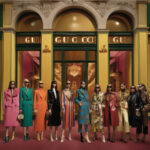In a digital-first world, brands like Summer Fridays and Patrick Ta Beauty are employing traditional advertising methods to enhance their visibility and reach a broader audience. While their primary success has stemmed from astute social media strategies, a shift towards out-of-home (OOH) campaigns showcases a strategic pivot that can redefine how beauty brands relate to their consumers.
Summer Fridays, co-founded by influencers Marianna Hewitt and Lauren Gores, has cultivated a remarkable online presence, amassing over one million followers on Instagram. Their viral products, including the colorful Lip Butter Balm and the acclaimed “Jet Lag Mask,” are crafted to thrive in digital ecosystems. However, this digital savvy brand has made bold moves into the offline advertising realm by employing billboards, taxis, and even TSA security bins to capture the attention of potential customers away from their screens.
“We’re a social- and digital-first brand, but we don’t want to just reach the people that can see us on social [media]. If it can be advertised on, we’re exploring it,” stated Hewitt. This desire to explore unconventional avenues is central to their strategy, as they aim to resonate with audiences that may not engage with their digital content regularly.
The beauty industry has witnessed a pivotal transformation in recent years, prompting brands to rethink their marketing strategies. Although digital marketing comes with the advantage of tracking and analytics, it often tends to reach a limited audience—those entrenched in the brand’s digital ecosystem. Additionally, fluctuations in advertising costs and effectiveness, particularly after privacy shifts introduced by technology platforms, can lead to unpredictable returns on investment.
For brands like Innbeauty Project, the case for OOH advertising is compelling. “Our customer might be 20 years old… but also they might be much older,” explained co-founder Alisa Metzger. This all-encompassing approach acknowledges the varied demographics that a beauty brand can serve, encouraging inclusivity.
As remarkable as the rise of DTC (direct-to-consumer) beauty brands has been, the digital space is now saturated with indie and celebrity-backed products. Standing out in this crowded market requires tangible, real-world presence—a differentiator that OOH advertising can provide. Successful campaigns necessitate a unique approach, highlighting the need for location targeting and a deep understanding of audience behaviors. For instance, when planning its first major OOH campaign, Patrick Ta Beauty chose the tagline “beauty that brings you out,” a simple yet emotionally resonant message that aligns with personal narratives of self-realization.
Moreover, the investment in such campaigns is substantial. Patrick Ta Beauty allocated over $1 million for a campaign featuring high-profile platforms such as billboards and Times Square ads. The payoff has proven effective, with a 40% increase in search terms related to the brand observed shortly after the campaign launch. Such results illustrate how strategic placements can drive online activity, reaffirming the idea that offline engagement translates into real-world interest.
The effective use of visuals is also essential. Creative director Ellen Yoon states that product imagery—particularly displaying actual skin textures rather than heavily retouched images—can be more captivating and approachable for consumers. Brands now recognize the need for straightforward and impactful visuals that communicate product values and brand essence at first glance.
Timing plays a critical role in the efficacy of OOH campaigns. For Innbeauty Project, aligning the launch of their first major OOH advertisement with their expansion into Sephora allowed for a simultaneous marketing strategy. The result? A staggering 800% increase in sales for the featured product, Extreme Cream, within the first two weeks. This illustrates the potential of coordinated campaigns to amplify brand messaging and drive sales during pivotal moments.
Furthermore, the integration of local demographics into advertising strategies can magnify success. Brands are carefully selecting high-traffic locations where their ideal customers tend to frequent, such as cafes and shopping districts. For example, Summer Fridays frequently chooses to advertise adjacent to Sephora locations, effectively making it one of the last brands consumers see before entering the store—a calculated move to enhance in-store conversions.
The role of influencers remains crucial in bridging the gap between offline campaigns and online buzz. Featuring models and influencers who have a real connection with their audience can spur social media shares and discussions, enhancing the digital footprint of an OOH advertising effort. During their TSA takeover, Summer Fridays leveraged TikTok trends to create a buzz around their presence at airport security, illustrating the ongoing synergy between traditional and digital marketing channels.
In a post-pandemic landscape where brands must continually innovate to stay relevant, embracing a blend of traditional and digital marketing strategies proves vital. The resurgence of OOH advertising by beauty brands signals a recognition that meaningful engagement extends beyond the screens. Brands that thoughtfully integrate their campaigns with a focus on inclusivity, creativity, and strategic timing stand poised to capitalize on a vast array of opportunities as they navigate this transitional phase in consumer connections.
By reevaluating the essence of branding and retaining an inventive spirit, these beauty brands exemplify how the future of advertising can harmoniously blend the old and the new.












